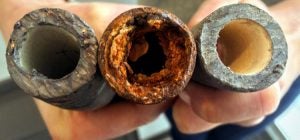
State legislation requires replacement of ¼ of the country’s lead pipes
Tom Neltner, Chemicals Policy Director
With the recent passage of excellent legislation in Illinois and New Jersey, one out of every four of the nation’s lead service lines (LSLs) is on a mandatory schedule to be fully replaced, with strict limits on partial replacement in the interim. These states now join Michigan in leading the way on replacing lead pipes– made all the more important because they have some of the highest numbers of LSLs in the country.
Both the Illinois and New Jersey laws[1] were the result of extensive negotiations between stakeholders and were passed with broad bipartisan support. We applaud the bill sponsors and the advocacy organizations that made it happen.
The most significant difference between the three state policies is their deadlines for utilities to fully replace the LSLs:
- Illinois: range of 15 years to 50 years depending on a given utility’s number of LSLs.
- New Jersey: 10-year deadline with an option to extend to 15 years
- Michigan: 20-year deadline.
Our understanding from local stakeholders is that the schedule in the three states was largely constrained by the financial burden on the community. If Congress provides $45 billion in funding to fully replace the nation’s estimated 9 million LSLs as called for in the Biden Administration’s American Jobs Plan, the utilities, not just in these three states but across the country, could likely move much faster on replacement.
Below is a comparison of the key features of each state’s LSL replacement requirements.
| Feature | Illinois | Michigan | New Jersey |
|---|---|---|---|
| Estimated percent of nation’s LSLs | 12% | 7.5% | 5.7% |
| Source of directive | 2021 Statute – HB 3739 | 2018 revision to state’s lead and copper rule | 2021 Statute – A5343 |
| Full replacement schedule | 2042 to 2077 depending on utility’s number of LSLs. | 2040 (accelerated in case of lead action level exceeded). | 2031 years with option for 5 more years. |
| Definition of LSL | Includes pigtails and downstream galvanized | ||
| Ban on partial LSL replacements | Effective 1/22 | Effective 2018 | Effective when Governor signs. |
| Exemptions to ban on partials | Emergency repair and owner/occupant does not cooperate. | Emergency repair | Emergency repair of main or service line and last resort after good faith effort. |
| Service line materials inventory | Initial due 4/22, With update due 4/23 and final due 4/24. Extensions possible. | Initial due 1/20 with final due 1/25. | Initial due 1/22 with annual updates until all LSLs replaced. |
| Replacement plan | Initial due 4/24 with annual updates until final is due 4/27. Opportunity for public comment. | Annual reports on status of replacement efforts. | Initial due 7/22 with annual updates until all LSLs replaced. |
| Customer financial contribution | May be required unless work funded by state grant. Rates may cover costs. | Not allowed (except as part of rates paid by all). | May be required for cost not covered by state assistance. Rates may also cover costs. |
Other states should step up to make similar commitments – particularly those with the most LSLs – to protect people from lead, create jobs, and reduce inequities.
[1] Each bill is awaiting Governor’s signature.












